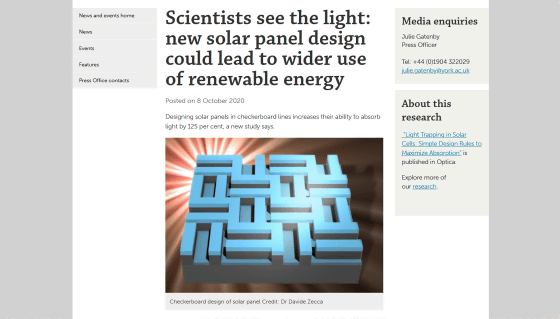Research results show that adding a 'simple pattern' to the surface of a solar panel will more than double the light absorption efficiency.

In recent years, research and introduction of renewable energy have been promoted all over the world, and the efficiency of power generation such as solar power generation is gradually increasing. A study conducted by the
OSA | Light trapping in solar cells: simple design rules to maximize absorption
https://www.osapublishing.org/optica/abstract.cfm?uri=optica-7-10-1377
Scientists see the light: new solar panel design could lead to wider use of renewable energy --News and events, The University of York
https://www.york.ac.uk/news-and-events/news/2020/research/solar-panel-design-renewable-energy/

Etching a Simple Pattern on Solar Panels Boosts Light Absorption by 125%, Study Shows
Prior to this research, we will improve the efficiency of photovoltaic power generation, such as developing a photovoltaic power generation system that can operate 24 hours a day , using algae for photovoltaic power generation, and photovoltaic power generation using transparent solar panels . Therefore, various studies have been conducted.
All attempts are aimed at a world that is less dependent on fossil fuels, but research teams such as the University of York are looking for ways to increase power generation efficiency with only minor changes to existing PV technology. Was there. The research team noticed that it was a method of 'adjusting the surface structure of crystalline silicon ( solar grade silicon ) used for solar panels.'
Photovoltaic power generation is generated by the absorption of sunlight by the solar panel, so if the absorption efficiency of sunlight can be improved, the power generation efficiency will also increase. The research team decided to devise a surface structure design that would reduce the proportion of sunlight reflected by the solar panel and trap more sunlight.

In devising the surface structure of solar panels, the research team absorbs sunlight based on a simple 'grid pattern' rather than considering new structural designs based on patterns that exist in nature or computer algorithms. I sought a way to optimize.
The research team has determined the light absorption efficiency of solar panels made from solar-grade silicon, which is only 1 micrometer thick, in a 'simple grid', 'crossed grid', and 'checkerboard pattern ( checkerboard pattern ) grid'. We simulated with various surface structures consisting of a grid-like pattern. In addition, the light absorption efficiency was also compared for the structure in which each pattern was randomly rotated in a specific unit.
As a result of the simulation, it was found that the checkerboard pattern, in which the grid pattern rotates randomly, produces more electricity than any of the patterns compared. It was suggested that it produces about 125% more electricity than conventional solar cells that do not have a grid pattern. In addition, the researchers claim that the checkerboard pattern, which consists of a grid pattern, has a simple structure and is easier to produce on an industrial scale than other solar panels with complex nanostructures.

by The Optical Society
'Our idea is comparable to enhancing the light absorption efficiency of a more sophisticated design,' said Dr. Christian Schuster of the research team. He also said that the checkerboard design would enable the production of thinner solar panels, reducing the energy required for manufacturing and integrating solar panels into thinner materials.
The checkerboard pattern design principles are useful not only in photovoltaics, but also in related areas that rely on physical functions similar to light diffraction, such as acoustic noise shields, storm panels, and non-slip. Pointed out.
Related Posts:







